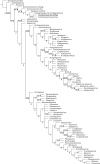A new confuciusornithid bird with a secondary epiphyseal ossification reveals phylogenetic changes in confuciusornithid flight mode
- PMID: 36543908
- PMCID: PMC9772404
- DOI: 10.1038/s42003-022-04316-6
A new confuciusornithid bird with a secondary epiphyseal ossification reveals phylogenetic changes in confuciusornithid flight mode
Abstract
The confuciusornithids are the earliest known beaked birds, and constitute the only species-rich clade of Early Cretaceous pygostylian birds that existed prior to the cladogenesis of Ornithothoraces. Here, we report a new confuciusornithid species from the Lower Cretaceous of western Liaoning, northeastern China. Compared to other confuciusornithids, this new species and the recently reported Yangavis confucii both show evidence of stronger flight capability, although the wings of the two taxa differ from one another in many respects. Our aerodynamic analyses under phylogeny indicate that varying modes of flight adaptation emerged across the diversity of confuciusornithids, and to a lesser degree over the course of their ontogeny, and specifically suggest that both a trend towards improved flight capability and a change in flight strategy occurred in confuciusornithid evolution. The new confuciusornithid differs most saliently from other Mesozoic birds in having an extra cushion-like bone in the first digit of the wing, a highly unusual feature that may have helped to meet the functional demands of flight at a stage when skeletal growth was still incomplete. The new find strikingly exemplifies the morphological, developmental and functional diversity of the first beaked birds.
© 2022. The Author(s).
Conflict of interest statement
The authors declare no competing interests.
Figures









Similar articles
-
A new clade of basal Early Cretaceous pygostylian birds and developmental plasticity of the avian shoulder girdle.Proc Natl Acad Sci U S A. 2018 Oct 16;115(42):10708-10713. doi: 10.1073/pnas.1812176115. Epub 2018 Sep 24. Proc Natl Acad Sci U S A. 2018. PMID: 30249638 Free PMC article.
-
Insight into the evolution of avian flight from a new clade of Early Cretaceous ornithurines from China and the morphology of Yixianornis grabaui.J Anat. 2006 Mar;208(3):287-308. doi: 10.1111/j.1469-7580.2006.00534.x. J Anat. 2006. PMID: 16533313 Free PMC article.
-
Ontogenetic niche shifts in the Mesozoic bird Confuciusornis sanctus.Curr Biol. 2022 Apr 11;32(7):1629-1634.e2. doi: 10.1016/j.cub.2022.02.010. Epub 2022 Mar 2. Curr Biol. 2022. PMID: 35240049
-
The origin and early evolution of birds: discoveries, disputes, and perspectives from fossil evidence.Naturwissenschaften. 2004 Oct;91(10):455-71. doi: 10.1007/s00114-004-0570-4. Naturwissenschaften. 2004. PMID: 15365634 Review.
-
An integrative approach to understanding bird origins.Science. 2014 Dec 12;346(6215):1253293. doi: 10.1126/science.1253293. Science. 2014. PMID: 25504729 Review.
Cited by
-
Transformation of the pectoral girdle in pennaraptorans: critical steps in the formation of the modern avian shoulder joint.PeerJ. 2024 Feb 29;12:e16960. doi: 10.7717/peerj.16960. eCollection 2024. PeerJ. 2024. PMID: 38436017 Free PMC article.
References
-
- Zhou ZH, Zhang FC. Mesozoic birds of China: a synoptic review. Vertebr. PalAsiat. 2006;44:74–98.
-
- Hou LH, Zhou ZH, Gu YC, Zhang H. Confuciusornis sanctus, a new Late Jurassic sauriurine bird from China. Chin. Sci. Bull. 1995;40:1545–1551.
-
- Chiappe LM, Ji SA, Ji Q, Norell MA. Anatomy and systematics of the Confuciusornithidae (Theropoda: Aves) from the Late Mesozoic of northeastern China. Bull. Am. Mus. Nat. Hist. 1999;242:1–89.
-
- Zhang FC, Zhou ZH, Benton MJ. A primitive confuciusornithid bird from China and its implications for early avian flight. Sci. China Ser. D Earth Sci. 2008;51:625–639. doi: 10.1007/s11430-008-0050-3. - DOI
-
- Wang M, O’Connor JK, Zhou ZH. A taxonomical revision of the Confuciusornithiformes (Aves: Pygostylia) Vertebr. PalAsiat. 2018;57:1–37.
Publication types
MeSH terms
LinkOut - more resources
Full Text Sources

